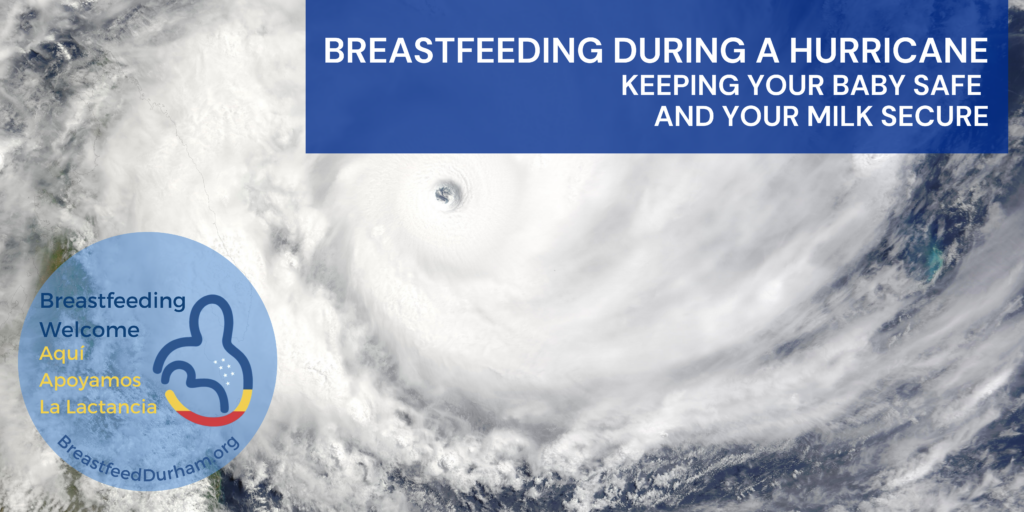Are you in the path of a hurricane or tropical storm? Are you wondering how to keep your breastmilk safe during a potential power outage or if there are benefits to nursing through a storm? Read on for crucial information on breastfeeding during a hurricane.
Keeping Baby Close
Breastfeeding is a safe and effective way to feed your child in an emergency. Here’s why:
- Always Available: Human milk is always clean, requires no fuel, water, or electricity, and is readily available when baby and nursing parent are kept close.
- Health Benefits: Human milk contains antibodies that fight infection, including diarrhea and respiratory infections that are common among infants in emergency situations.
- Stress Relief: Breastfeeding releases hormones that lower stress and anxiety in both the child and the nursing parent. During stressful times, it’s important to continue offering the breast or expressing milk at regular intervals.
- Illness Protection: If a baby (or parent) becomes ill, continuing breastfeeding provides the baby with human antibodies that fight the illness.
If you are in the process of weaning, it is best to continue nursing until the emergency passes.
Expressing Milk During a Hurricane
Expressing milk should continue at the same rate or more frequently during an emergency. Here are some tips:
- Keep Your Pump Close: If you have a hand pump, plan to evacuate with both your electrical pump and hand pump. Hand expression is also an effective tool for removing milk that does not require equipment or sanitation besides a clean container and washed hands.
- Sanitize When Possible: Take advantage of any situation where you can safely wash your pump parts. If you do not have safe, clean water, consider hand expression instead.
Feeding Expressed Milk During a Hurricane
- Sanitization: It can be difficult to sanitize bottles and bottle teats in an emergency. Cups, including disposable cups, can be used instead, even for newborns. Find more about cup feeding here.
- Safety Precautions: According to the CDC, throw out bottle nipples or pacifiers that have been in contact with floodwater.
Packing Your Frozen Milk for Evacuation
Here’s how to pack your frozen milk effectively:
- Use a Well-Insulated Cooler: Line the bottom with newspaper.
- Pack Tightly: Place your milk bags in the cooler and fill any extra space with more crumpled newspaper to ensure it stays cold longer.
- Layering: Place another layer of newspaper on top of the milk, followed by frozen gel packs or ice blocks.
- Sealing: Consider sealing your cooler with duct tape to improve the seal and prevent it from opening and spilling the milk.
- Keep Closed: Keep the cooler closed until you reach your destination freezer.
Dry ice may be used in place of gel packs or regular ice, but it requires additional safety precautions and should not come in direct contact with milk bags.
Leaving Frozen Milk Behind
Do not delay evacuating because of your frozen milk. Ideally, your goal is to prevent your milk from thawing completely. Here’s how to prepare:
- Adjust Temperature: Before a storm, set the fridge/freezer temperature control to the coldest setting.
- Full Freezer: Make sure your freezer is as full as possible with your milk in the center. A full freezer stays frozen longer.
- Reduce Air Flow: Fill empty space in the freezer with crumpled newspaper.
- Keep Closed: Keep the freezer door completely closed once prepped.
When you return to your milk, check for ice crystals. If any remain, the milk may be refrozen. If no ice crystals are present, use the milk within 24-48 hours and do not refreeze.
Additional Resources
Here are some resources to support breastfeeding and infant feeding policies and practices in emergencies:
- 1,000 Days: 5 Things You Need to Know About Breastfeeding in Emergencies
- Centers for Disease Control and Prevention (CDC):
- Disaster Planning: Infant and Child Feeding
- Infant and Young Child Feeding in Emergencies Toolkit webpage
- Infant and Young Child Feeding in Emergencies Toolkit PDF
- Concerns Regarding Donations of Infant Formula and Infant Feeding Items During an Emergency webpage
- Concerns Regarding Donations of Infant Formula and Infant Feeding Items During an Emergency PDF
- Emergency Nutrition Network | Infant Feeding in Emergencies (IFE) Core Group:
- Global Breastfeeding Collective: Advocacy Brief Breastfeeding in Emergency Situations
- International Lactation Consultant Association (ILCA):
- La Leche League (LLL):
- La Leche League International Infant Feeding in Emergencies (Multilingual)
- La Leche League GB Breastfeeding in Emergency Situations
- LLL USA Breastfeeding in an Emergency
- Save the Children Infant and Young Child Feeding in Emergencies toolkit
- United States Breastfeeding Committee (USBC): Infant and Young Child Feeding in Emergencies, including COVID-19
- World Health Organization (WHO): Pregnancy, childbirth, breastfeeding and COVID-19
- World Vision: Breastfeeding in Emergencies
This article was adapted from content previously available LLLDurham.org website, which linked to LLL USA resources that are no longer active. We’ve updated and reposted the information to ensure it remains accessible to our community.
Stay safe, prepared, and continue to nurture your baby through the storm.

